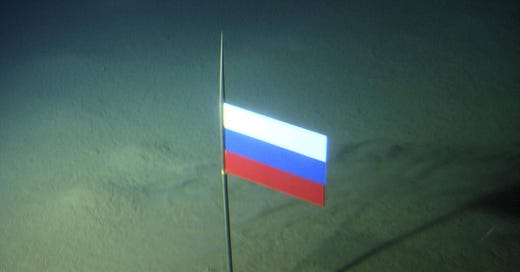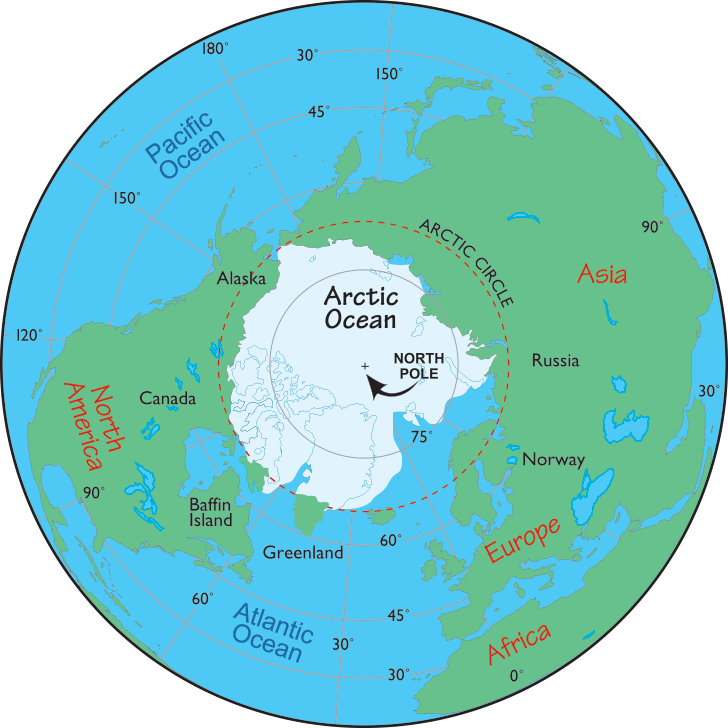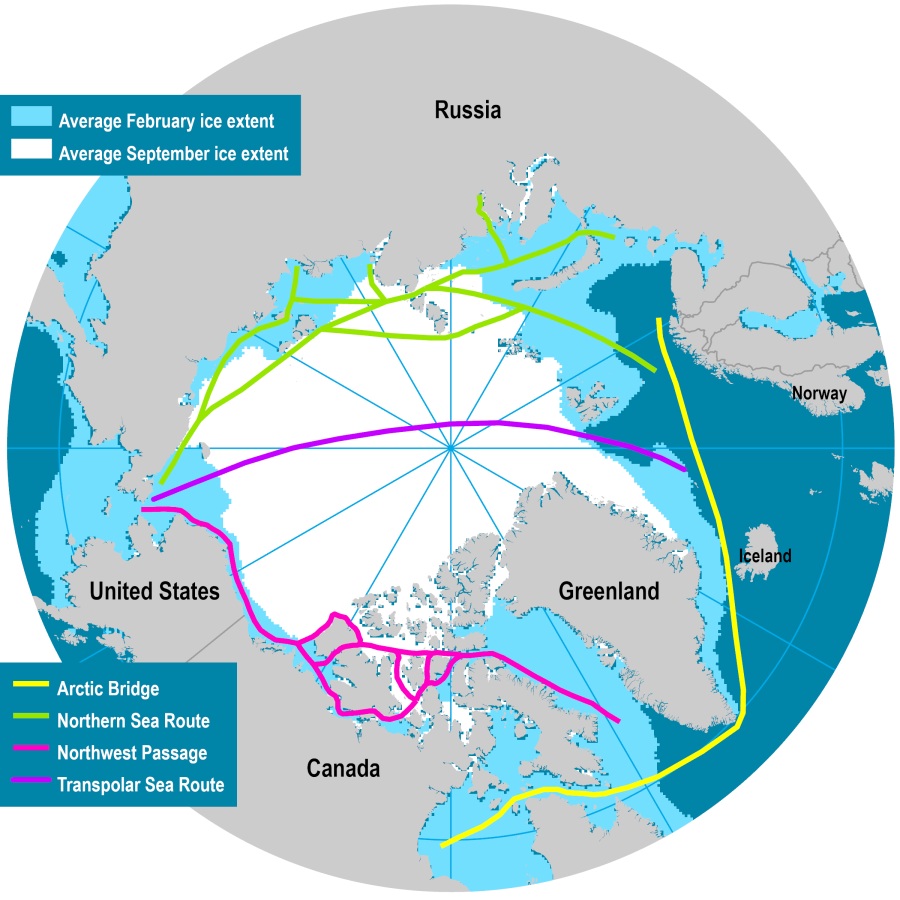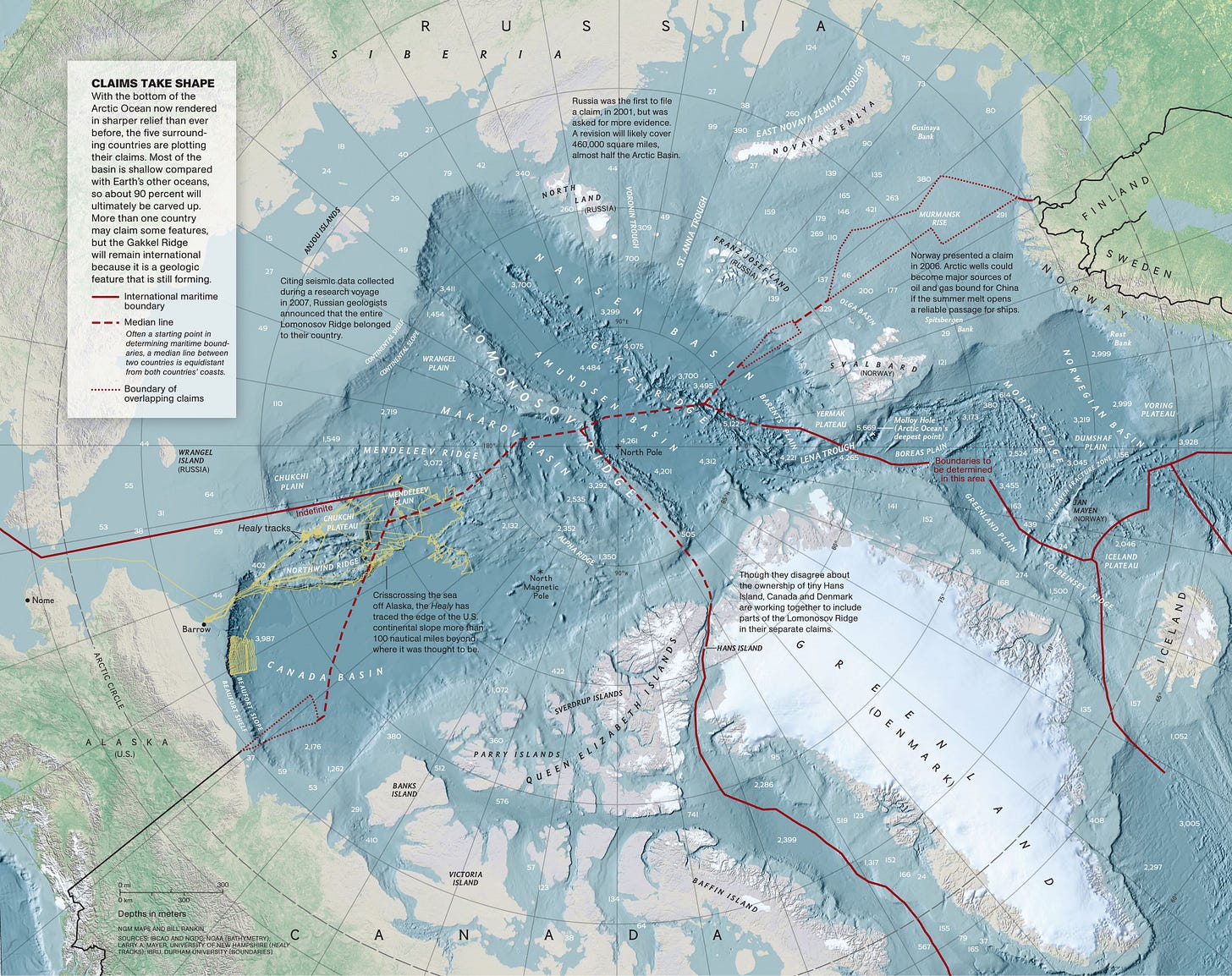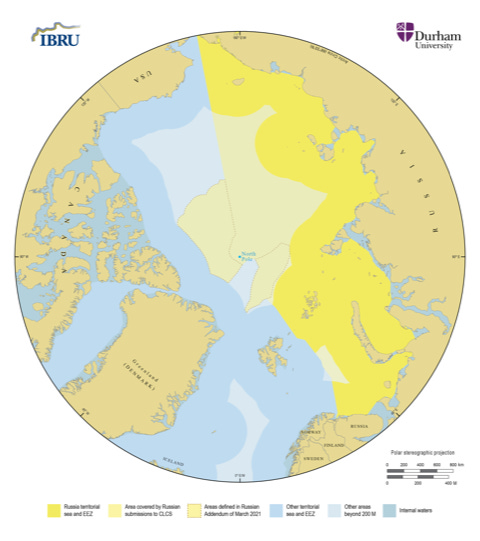Annexing the Arctic: 2022
Russia's quest for world dominance and how that impacts the North Pole
Russia, it seems, likes to place itself at the center of attention nowadays. Lately its war of aggression in Ukraine is rightfully taking over the headlines; many journalists and analysts are reminding us that Putin has been behaving as if actions have no consequences for some time. They like to point out the USSR’s wars in Czechoslovakia, Chechnya, and Afghanistan as well as Putin’s more recent annexation of Crimea. Besides being exercises in military might, what all these events have in common is that they affected independent, sovereign nations. But what if Russia begins to claim territory where there is neither government nor people to oppose him?
Since the beginning of the 21st century, Russia has increased its claim to the Arctic, going so far as planting a flag on the seabed beneath the North Pole:
How can a country make these claims, let alone substantiate them? How have other countries responded? And most importantly, what actions has Russia taken to realize its sovereignty over the Arctic? Before we can begin to answer those questions, let’s break down each part of the story.
What is the North Pole?
The North Pole is a geographic area that sits at the top of Earth. It is in the center of the Arctic Ocean, and because it is in open water it’s almost always covered by 6-10 feet of ice. The North Star, Polaris, hovers exactly above the Pole, which receives 24 hours of daylight in the summer and 24 hours of darkness in the winter. It is where the planet’s axis of rotation meets the earth’s surface, and it is often referred to as True North — not to be confused with the Magnetic North, which is elsewhere in the Arctic Circle. The Arctic Circle is a roughly 1,000 square mile-radius that extends from the Pole into North America, Europe, and Asia (see map below):
Why is the Arctic unique?
The Arctic is not a continent like the Antarctic, which has its own ocean (the Southern Ocean). It is merely an area of open, icy water — the depth of the ocean at the North Pole is more than 4,000 meters or 13,123 feet! The Arctic Circle has a small ecosystem (the word “arctic” comes from arktikos, Greek for “near the bear”) but rarely do its flora and fauna venture onto the Pole itself. Large marine and terrestrial mammals are rare, but birds such as the Arctic Tern make frequent visits. Under the ice there is much more diversity: Arctic Cod feed on shrimp, anemones, and other crustaceans. The ice acts as an insulator during the winter, preventing the comparatively hot ocean from warming the Arctic’s air (remember, saltwater freezes at roughly 28°F, but the average Arctic winter temperatures is -30°F!). The water is also far saltier, denser, and richer in nutrients than any other ocean.
Why is the Arctic, a place where few people live, important to the rest of the world?
While many Indigenous peoples live in the Arctic Circle, the area is almost entirely ocean as stated above. The Arctic is the largest repository of sea ice, which is important for reflecting the sun’s rays and keeping Earth’s climate in check (a topic I will explain in depth later in this newsletter). In the past many explorers, most notably Frederick Albert Cook & Roald Amundsen, ventured to the North Pole, but today the area is used mainly by military and cargo ships. Scientists deploy drifting research stations, which float in floes of sea ice and collect data about the ocean & atmosphere. Large ships called icebreakers perpetually cut a path through the ice, allowing goods to travel quickly in between continents via the Northern Sea Route. See a map of the routes below:
Interestingly, the first people verified to have set foot on the sea-ice-covered North Pole were a group of Soviet oceanographers in 1948. But American, British, and Norwegian adventurers and scientists had previously and have since explored the Arctic, so this has little to do with Russia’s current territorial claims.
What does Putin think gives him the right to claim the Arctic?
The earth has two kinds of crust: continental and oceanic. The continental crust Russia exists on extends well into the Arctic via an undersea mountain range, so Putin/the Russians believe that part of the world is Russian territory.
The Lomonosov Ridge (left-central area of the above map) is one of the four recognizes disputed territories in the Arctic and the only one that Russia has claimed is made up of its continental crust. On a 2007 exploratory submarine mission, Russian scientists discovered/decided that the North Pole was located on the Lomonosov Ridge and thus was part of Russia (hence why they planted a flag). But as you can see in the map above, the North Pole is in open water just off of the Lomonosov Ridge. Since 2001, Russia has continuously filed reports with the United Nations’ Commission on the Limits of the Continental Shelf seeking to redefine its outer limits. Past claims have been rejected by the committee. Most recently, its 2021 report seeks to make the Lomonosov Ridge as well as other parts of the Ocean belonging to Canada & Denmark as internationally-recognized Russian territory. Russian scientists have continued to study (or “study”) the ocean floor, publishing new findings that support the government’s desire to take control of the Arctic Ocean.
Why is this a problem?
Per established international law, no country can claim the North Pole nor the entire Arctic Ocean as their own. In addition to Russia, Canada, Denmark, the US, Norway, Sweden, Iceland, and Finland also claim parts of the Arctic; all eight nations are part of the Arctic Council, the only intergovernmental organization in the Arctic. Each nation with coastline on the Arctic has a 200-mile Exclusive Economic Zone (EEZ) where their research vessels and cargo liners can sail peacefully. However, the North Pole and other somewhat navigable parts of the ocean exist outside of anyone’s EEZ in international waters, represented in pale blue in the map below. You can see Russia’s EEZ, indicated by the bright yellow; the light yellow is its latest territorial claims, which encroach upon Canada & Denmark’s EEZs. If Russia’s 2021 report is approved, it would control nearly 70% of the international waters in the Arctic, including the North Pole:
One reason why the Arctic is so vital to 21st century politics is that the U.S. Geological Survey estimates the Arctic holds 13% of the world’s undiscovered oil and 30% of its natural gas resources. As Arctic Today wrote in about Russia 2021,
“Their underlying interests are substantial. A successful claim will bring with it exclusive rights to all resources below the seabed, such as oil and gas, minerals or any other resources — though not resources in the water column, on the ocean surface or in the airspace above. With the rights to the resources on the seabed follow also certain rights to regulate traffic in the area in order to protect those riches on the seabed.”
To make matters worse, the frequency of such territorial disputes will only increase as the climate warms. This is an example of a phenomenon called a positive feedback loop. It goes like this: warmer temperatures cause sea ice to melt — less sea ice means less heat is reflected back into the earth’s atmosphere & more heat is absorbed by the ocean — a warmer ocean cannot freeze as easily, so less sea is created the following winter — less sea ice means less heat is reflected and more heat is absorbed — a warmer ocean makes less sea ice, etc. etc. The Arctic Ocean transforms from a place where the most heat is reflected to one where the most heat is absorbed. This is why the polar regions are warming at a faster rate than the rest of the earth.
Thus, the Arctic will become more navigable as the years go by. Areas that were previously frozen year-round, specifically those outside of any country’s EEZ, will soon be vulnerable to colonization by hostile nations like Russia.
What current measures is Russia taking to ensure it owns the Arctic?
Besides planting a flag at the bottom of the ocean you mean? Last year the Moscow Times reported that Russia is amassing new military bases and testing advanced weapons on its Arctic coastline. Recently Russia has insisted that ships traveling via the Northern Sea Route take Russian pilots aboard. The Canada-based Fraser Institute has also reported instances of Russian aggression:
“Russian long-range bombers have started flying sorties again in the region, after nearly two decades of post-Cold War peace. The Canadian military reports that there have been 50 Russian incursions in the last three years. The most recent of these unfriendly flights occurred late last month, when a pair of Russian Tu-95 bombers approached Goose Bay … Russias claims are different than that of other Arctic nations both in the way the claims are being made and in the nature of the claims: Other nations are not laying claim to half of the region or the entire North Pole. Other nations are not making territorial claims in a blatant military context.”
And in 2015, a research mission of Russian scientists studied the makeup of Alaska’s Chukchi Plateau to determine whether it could be considered Russian continental crust(!). Yet another, but less talked-about, instance of Russia’s military staking out their unsubstantiated territorial claims. I believe media outlets do not give the Arctic Ocean enough attention, not only because few people live there but because the geography of the area is complex and constantly changing. And as I mentioned above, this problem will only worsen as the climate quickly warms.
And last but not least…
Why should we care?
For the same reasons we should care about Russia’s annexation of land above sea level: it sets an example for other countries with authoritarian leanings (ahem China) that one can claim what one cannot prove. This attempt to blindly control a space that belongs to multiple countries is just as dangerous as its takeovers of singular existing nations. And yet, the Arctic is as important for commerce as it is for conservation. The Arctic has become a region of the world that is both volatile and vulnerable. It’s important to observe the effects of climate change in the poles, knowing that similar phenomena will soon happen in the rest of the world. If the Arctic becomes a place of territorial disputes and political warfare, scientists will be unable to research the state of and changes to our climate. Countries must work together, especially now, to ensure the integrity of our global mission to combat climate change and protect our oceans from harm. We humans rely on the sea more than we think — as Pablo Neruda’s poem “The Sea” concludes,
the quiet power out there, sure as a stone shrine in the depths, replaced my world in which were growing stubborn sorrow, gathering oblivion, and my life changed suddenly: as I became part of its pure movement.
See below for the second installment of Annexing the Arctic:
Sources:
World Atlas graphic of the North Pole | National Geographic: The North Pole, n.d. | Arctic Today: Russia Extends Its Claim to the Arctic Ocean Seabed, 14 April 2021. | The Moscow Times: Russia Claims the Continental Shelf in Arctic Ocean, 12 April 2021. | Fraser Institute: Meeting Russia's Arctic Aggression, n.d. | Organization for World Peace: Arctic Circle Territorial Conflicts, n.d. | Map of territorial claims by Russia in the Arctic | Polar shipping routes graphic | Durham University’s map of Arctic EEZs

